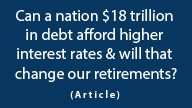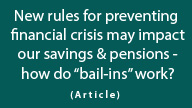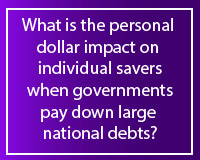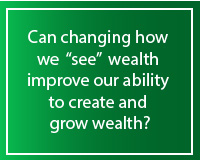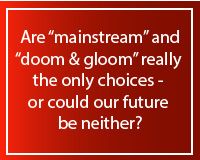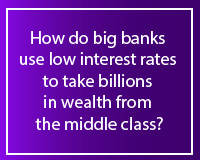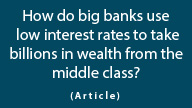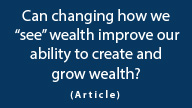Does Economic Stagnation Create Dangerous Financial Bubbles?
By Daniel R. Amerman, CFA
Below is the 2nd half of this article, and it begins where the 1st half which is carried on other websites left off. If you would prefer to read (or link) the article in single page form, the private one page version for subscribers can be found here:
Is Secular Stagnation The Source Of Current Stock Index Highs?
Now isn't it fascinating that even as we are six years into a period that many leading economists are now calling a new normal of secular stagnation, we're simultaneously seeing record stock prices with the S&P 500 above the 2,000 level and the Dow Jones above 18,000? (To be more accurate, these are records on a non-inflation-adjusted basis, which is typically how bull markets are presented.)
Is this a coincidence, or could currently soaring stock market levels be an example of exactly the type of secular stagnation-created financial bubbles that are expected by these economists?
Let's consider what's happening.
We have near zero interest rates that are negative in real terms.
As has been reported upon time and again, we continue to have persistent high unemployment in the United States when we adjust for workforce participation rates, even while the headlines focus on the partial measure of headline unemployment.
The United States may or may not have emerged from the "Great Recession" (it really depends upon whatever inflation rate you're using in the calculation of GDP), but Europe, which is a key trading partner and key component of corporate profits for the United States, continues to struggle to emerge from recession.
So we have extraordinary stock valuation levels in a time of still low and unreliable growth, while vast supplies of low cost money flood the financial system as the result of central banking actions.
The other remarkable thing that is happening is that there are various major risks developing in the world even while the stock market is surging.
As one example, after being briefly held back because of the geopolitical risk associated with the Ukraine in particular, the level of 2,000 for the S&P 500 was reached for the first time the very same week that we had credible evidence for not just one, but potentially two different armored columns of Russian troops being placed in the Ukraine in different locations.
Currently we are seeing near record highs even as the election of the far left Syriza party in Greece has created a high risk situation in Europe, as further explored here. Now, as shown in the most recent release of the minutes from the Federal Reserve, the US economy is in their opinion still in such fragile condition that they don't dare raise interest rates in the near term. So we have a weak and fragile economy, even while there is a respectable chance (albeit far from a certainty) that global financial order could be overturned in the coming weeks – and the markets just shrug off those concerns, as prices keep on rising.
As another interesting example, record index levels are being reached at the same time that the hacking of electronic payment systems moves from mere novelty to becoming routine, with news emerging in the last year about numerous major corporations having been compromised.
Now taking into account that the great majority of the United States economy is based on the electronic flow of money, let me suggest that this new reality of the electronic flow of money from consumers to companies being much more vulnerable than previously recognized – with the exploitation of these vulnerabilities perhaps not entirely coincidentally often coming from predominantly Russian and Eastern European hackers – is an extraordinary threat to potential future profitability.
And yet, The Party goes on, creating its own weather pattern that seems near oblivious to these emerging risks.
Markets that effortlessly shrug off dangerous developments as if they never happened and just keep on surging are nothing new; it's a well-established pattern that we've seen many times before. But when we put all of these real-world components together, we realize that the sources for the surge in the S&P 500 may be quite different indeed from what the overwhelming voice of The Crowd has been telling us. Which brings to mind a quotation from Charles Mackay, in his classic work "Extraordinary Popular Delusions and The Madness of Crowds":
"Men, it has been well said, think in herds; it will be seen that they go mad in herds, while they only recover their senses slowly, and one by one."
A Potential Nightmare Scenario For Retirement Investors
Once we leave the dry and impersonal language of economics behind and consider the very personal implications for us all, what is being described in the Secular Stagnation e-book is a potential nightmare scenario for society as a whole, and for older investors in particular.
As a quite deliberate matter of government policy and as explained here, savers likely face years of negative returns (when adjusted for inflation), because the prevailing view among economists is that forcing negative returns on savers is the best way to fight economic stagnation. So if we stick with conventional investment strategies, there are virtually no yields available unless one either ups the risk or participates in the bubbles that are likely to be created as a direct side-effect of those same stagnation-fighting policies. And if one participates in a bubble then one takes one's chances, because that's the thing about bubbles – you never know when they're going to pop.
What is someone to do?
If we go with the comfortable familiarity of The Crowd and bet everything on prosperity – but it turns out that we instead bought into a secular stagnation-created bubble, then we could lose almost everything, particularly if the popping of the bubble brings on a broader financial crisis.
On the other hand, a decision to not participate doesn't necessarily protect those following conventional investment strategies either.
If we bet on economic stagnation, then for an indefinite period of economic stagnation we must find a way to earn significant yields on an after-inflation basis or there is no building of wealth. This is a very challenging task in its own right.
Compounding the difficulty in finding a viable strategy is that at any tim,e there could be a collapse of one of the series of financial bubbles "blown" by the three-way combination of very low interest rates, lack of investment alternatives and an aging population, meaning we have to also simultaneously be prepared for a deep financial crisis, potentially worse than we saw in 2008.
However, while risk premiums have been stripped out by very low rates and economic stagnation, the actual risks of financial instability may be greater than ever, which could leave us with low yields right up until the time that the crisis eventually hits and slashes the value of our principal.
Yet, if we commit to the usual financial disaster preparation strategies but stagnation persists, and a mega crisis doesn't arrive for another five or ten years ─ if at all ─ then we have virtually no earnings in the interim, and in fact on an inflation-adjusted basis are likely taking losses the entire time period. If on the other hand genuine and sustainable prosperity does find a way to return, from a strategy performance perspective traditional crisis preparation strategies fare even worse, as there is the 1-2 combination of likely ongoing negative inflation-adjusted yields, even while there is the opportunity cost of not participating in surging markets.
This is a very powerful but real dilemma, with few solutions when it comes to either the usual mainstream financial choices or the conventional crisis preparation choices. I do strongly believe there are solutions, but they are not the usual solutions, and education is the first step.
 What you have just read is an analysis about just one of the ways in which a rapidly shifting world is removing the foundations beneath conventional investing - even while most investors continue to follow the traditional strategies, unaware of just how much the financial playing field has changed.
What you have just read is an analysis about just one of the ways in which a rapidly shifting world is removing the foundations beneath conventional investing - even while most investors continue to follow the traditional strategies, unaware of just how much the financial playing field has changed.
 A personal retirement "eye-opener" linked here shows how the government's actions to reduce interest payments on the national debt can reduce retirement investment wealth accumulation by 95% over thirty years, and how the government is reducing standards of living for those already retired by almost 50%.
A personal retirement "eye-opener" linked here shows how the government's actions to reduce interest payments on the national debt can reduce retirement investment wealth accumulation by 95% over thirty years, and how the government is reducing standards of living for those already retired by almost 50%.
 An "eye-opener" tutorial of a quite different kind is linked here, and it shows how governments use inflation and the tax code to take wealth from unknowing precious metals investors, so that the higher inflation goes, and the higher precious metals prices climb - the more of the investor's net worth ends up with the government.
An "eye-opener" tutorial of a quite different kind is linked here, and it shows how governments use inflation and the tax code to take wealth from unknowing precious metals investors, so that the higher inflation goes, and the higher precious metals prices climb - the more of the investor's net worth ends up with the government.
 Another "eye-opener" tutorial is linked here, and it shows how governments can use the 1-2 combination of their control over both interest rates and inflation to take wealth from unsuspecting private savers in order to pay down massive public debts.
Another "eye-opener" tutorial is linked here, and it shows how governments can use the 1-2 combination of their control over both interest rates and inflation to take wealth from unsuspecting private savers in order to pay down massive public debts.







If you find these "eye-openers" to be interesting and useful, there is an entire free book of them available here, including many that are only in the book. The advantage to the book is that the tutorials can build on each other, so that in combination we can find ways of defending ourselves, and even learn how to position ourselves to benefit from the hidden redistributions of wealth.


